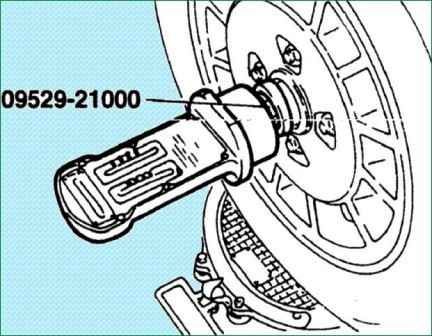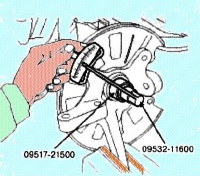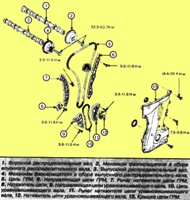Checking the angles of the front wheels must be carried out on a special stand, while the car must be in a horizontal position with the front wheels set for straight ahead
First make sure that the front suspension and steering are in good condition, tires and wheels are free of defects.
Toe-in
Toe-in is defined as the difference in the distances (B-A) between the front and rear sides of the wheel rims.
Positive toe means the front wheels are closer together than the rear, when measured at wheel midpoint height.
If the toe-in is not correct, loosen the left and right tie-rod end locknuts, then turn the tie-rods to the desired angle.
Tighten the locknuts.

Positive toe (B – A): -3mm…+3mm
Positive convergence (a+b): –17"11"…+17"11"
Turning 1/2 turn of the tie rods changes the positive toe by approximately 4.8mm (57"40").
Turning 1 turn of the tie rods changes the positive toe by approximately 9.6 mm (1°55"20").

Toe adjustment should be done by rotating the left and right tie rod ends at the same angle.
When adjusting the toe, loosen the outer collar securing the protective boot to prevent it from twisting.
After adjustment, tighten the tie rod lock nuts and boot clamps.
Tightening torque: 50 - 55 Nm
Camber
Camber is the angle of the wheel in relation to the road surface in a vertical plane.
It can be positive if the wheels are tilted outward, or negative if the wheels are tilted inward.
The camber angle is factory set and cannot be adjusted.

Collapse:
- 0°± 30" for normal suspension
- 8"± 30" for high suspension
King Pitch
The caster angle of the kingpin is set at the time of manufacture of the vehicle and cannot be adjusted.
If the kingpin caster angle is not as specified, replace any bent or damaged parts.

King Pitch: 3°15"±1°
Before checking and adjusting wheel alignment, the front suspension must be free of worn, loose, or damaged parts.
The wheel alignment must be done using the special tool 09529–21000.
Camber and kingpin caster are factory set and cannot be adjusted.
If the camber and caster angle are not as specified, replace bent or damaged parts.
Rear wheel alignment
Rear wheel toe-in: 2±2 mm
When adjusting the toe of the rear wheels, the adjusting bolt on the supporting transverse arms must turn the same angle on both sides of the vehicle.

Inside the vehicle: positive convergence
To the outside of the vehicle: negative toe
The scale is graduated to a scale of approximately 2.4 mm, which corresponds to a rotation angle of 14".
Rear camber
Rear camber:
- –30"±30" for regular pendant
- 38"±30" for high suspension
Before checking and adjusting wheel alignment, the rear suspension must be free of worn, loose, or damaged parts.
The camber is set when the vehicle and cannot be adjusted.
If camber is not within specification, replace bent or damaged parts.











